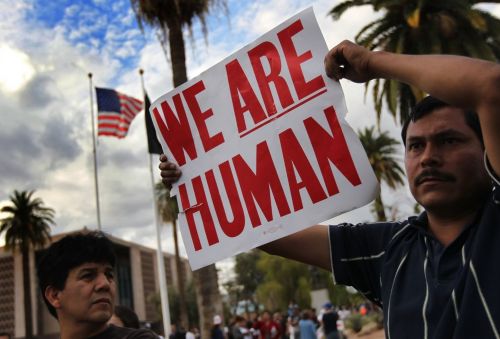

Donald Trump’s language toward immigrants is not simply colorful rhetoric; it is a strategy with deep historical roots and dangerous consequences.

By Matthew A. McIntosh
Public Historian
Brewminate
Introduction
Donald Trump’s return to the presidency has done nothing to soften his message on immigration. From his very first campaign speech in 2016, when he claimed Mexican migrants were “bringing drugs” and “bringing crime,” to his recent warnings that immigrants are “poisoning the blood of our country”, Trump has relied on a rhetorical arsenal built on fear and dehumanization. He has called migrants “animals”, accused them of spreading “bad genes”, and described undocumented families as “infesting” the nation.
The persistence of this language is not accidental. Scholars warn that framing people as less than human serves a political function: it makes punitive policies seem not only acceptable but necessary. Research shows that dehumanizing metaphors (casting immigrants as pests, floods, or criminals) are a cornerstone of authoritarian rhetoric. In Trump’s case, the parallels are chillingly clear. Just as Hitler and the Nazi regime once reduced Jews, Roma, and others to vermin or disease in order to justify persecution, Trump’s discourse strips migrants of individuality and dignity, paving the way for harsher treatment and diminished rights.
The Evolution of Trump’s Rhetoric
Trump’s dehumanizing language toward immigrants has followed a steady trajectory, from provocative campaign slogans to entrenched policy justification. In his 2016 campaign launch, he declared that Mexico was sending “rapists” and criminals across the border, setting the tone for years to come. Once in office, he escalated the metaphors, warning that undocumented migrants were “infesting” the country, and referring to them as “animals”.
The rhetoric has only intensified in his return to power. In a 2023 rally, he claimed that immigrants were “poisoning the blood of our country”, language that closely mirrors Nazi-era purity narratives. More recently, in an interview, he insisted that migrants who have committed violent crimes have introduced “a lot of bad genes” into the United States, a revival of discredited eugenics rhetoric.
This consistency reveals that Trump’s framing is not improvisational but strategic. By repeatedly associating immigrants with corruption, contamination, and criminality, he builds a worldview in which immigrants are a perpetual threat, unworthy of empathy or inclusion. His language is designed to shock, but also to normalize a climate in which harsher policies (detentions, deportations, and family separations) are seen as necessary safeguards rather than moral outrages.
Language and Dehumanization
The power of language in shaping political reality cannot be overstated. Trump’s immigration rhetoric repeatedly uses metaphors that reduce human beings to less-than-human categories: “animals,” “scum,” “bad genes,” or an “infestation.” Each term strips away individuality and dignity, presenting migrants not as people with families and histories, but as threats to be contained. Scholars argue that this tactic functions as a form of psychological distancing, making it easier for the public to accept harsh measures against those so labeled.
In her thesis Donald Trump and the Rhetorical Dehumanization of Migrants, Caitlin Conley documents how Trump has deliberately escalated these descriptors since 2016, creating a consistent pattern rather than a series of offhand remarks. Conley argues that these rhetorical choices create “permission structures” for policies that would otherwise be viewed as extreme or inhumane. The repetition of demeaning labels turns cruelty into common sense, reframing cruelty as protection.
This dynamic is not limited to the United States. Research from the American German Institute shows how far-right movements in Europe have relied on nearly identical strategies: casting immigrants as invaders, parasites, or polluters of national identity. The convergence across borders underscores how dehumanization is not an accident of rhetoric but a shared authoritarian toolkit. In each case, the goal is to reshape how the public sees newcomers, transforming them from neighbors into enemies.
The psychological impact of such language is well documented. Studies in political psychology reveal that when people are exposed to animal or disease metaphors about immigrants, they become more likely to support exclusionary or punitive policies. This dehumanizing frame alters not only public opinion but also moral imagination, creating a climate where violence and neglect appear justified. Once people are categorized as less than human, empathy shrinks, fear grows, and the line between political debate and persecution begins to vanish.
Historical Parallels
The structure of Trump’s rhetoric finds troubling resonance in the history of authoritarian regimes. The most infamous example is Nazi Germany, where Adolf Hitler and his propagandists described Jews, Roma, and others as Ungeziefer—vermin, parasites, or disease that had to be eradicated. These metaphors were not incidental insults. They laid the groundwork for persecution by stripping entire groups of people of their humanity, making mass violence thinkable. When Trump speaks of immigrants as “infestations” or claims they are “poisoning the blood” of the nation, the echoes are unmistakable.
This is not to argue for a simplistic equivalence between Trump and Hitler. The contexts and scales differ dramatically. But the rhetorical architecture is strikingly similar: a nation cast as pure or under siege, outsiders framed as a contagion, and the leader positioned as the defender who must act decisively to save the people. Historians note that this pattern (fear, dehumanization, and scapegoating) has been a hallmark of movements from fascist Italy to Hutu extremism in Rwanda. What links them is not identical policies, but the common use of language as a weapon of mobilization.
The American German Institute underscores this continuity by showing how far-right leaders in Europe today deploy rhetoric eerily close to that of both Hitler and Trump. In Hungary, Viktor Orbán has described refugees as “a poison” and “invaders,” while in France, Marine Le Pen has compared migrants to a “flood” overwhelming the nation. Such metaphors recur across continents and decades, reinforcing the conclusion that dehumanization is not a quirk of individual leaders but a tried and tested political strategy.
The danger lies not only in words but in the trajectory they signal. Once a group is successfully portrayed as a threat to purity, order, or survival, history shows the next step is escalation, from surveillance to exclusion, from exclusion to violence. The linguistic descent is the first step down a path whose end is all too familiar. Trump may not be Hitler, but his words open the same door that history has already shown can lead to catastrophic consequences.
Policy as Practice
Trump’s dehumanizing words are not isolated flourishes of rhetoric; they translate directly into policy. During his first administration, he presided over family separations at the southern border, a policy that became one of the defining scandals of his presidency. His second term has already revived the same logic, moving quickly to dismantle protections for vulnerable groups. Most recently, the administration announced it would end Temporary Protected Status for thousands of Syrians, leaving families who fled war newly vulnerable to deportation.
Immigration enforcement has also intensified at the ground level. In San Francisco, detainees have sued Immigration and Customs Enforcement, alleging that they were held in freezing, overcrowded cells without access to beds, showers, or adequate food. The lawsuit describes conditions that amount to “cruel and unusual punishment” and reflects a broader surge of ICE raids and detention abuses across the country. Such practices gain cover from Trump’s narrative that undocumented immigrants are not fully human and therefore undeserving of humane treatment.
By framing migrants as criminals and invaders, Trump has made harsh enforcement not only politically viable but, to his supporters, morally imperative. This feedback loop between rhetoric and policy normalizes escalating cruelty: once migrants are seen as pests or poison, even policies that would otherwise provoke outrage (raids at courthouses, indefinite detention, mass deportations) begin to seem like reasonable solutions. Dehumanizing language, in short, is the bridge between insult and institution.
Human and Health Costs
The consequences of dehumanizing rhetoric extend far beyond politics; they infiltrate the body and mind. Public health researchers warn that when leaders depict immigrants as less than human, the stigma translates into measurable harm. A recent study from UC Riverside found that dehumanizing immigration rhetoric harms public health by fostering stress, depression, and anxiety among immigrant communities. When people internalize that they are seen as threats rather than neighbors, the toll on mental and physical health compounds.
The stress is not abstract. Immigrant families often avoid clinics, schools, and even public spaces for fear of harassment, deportation, or discrimination. This retreat from daily life diminishes access to preventive healthcare, worsens chronic illnesses, and deepens economic precarity. In effect, the language used by political leaders becomes a barrier to essential services, undermining public health infrastructure itself.
Civil rights advocates also highlight the social damage. The Leadership Conference has documented how Trump’s narrative that immigrants are “criminals” produces ripple effects of fear, division, and distrust within communities. Families withdraw from civic engagement, neighbors become suspicious of each other, and children grow up under constant psychological pressure. The human cost of such rhetoric extends across generations, shaping not only how immigrants are treated but how they see themselves.
Perhaps most alarming is the correlation between dehumanizing language and real-world violence. Studies show that when public figures describe migrants as animals or vermin, hate crimes rise in the surrounding areas. Words create permission. Once stripped of personhood, immigrants become easier targets for vigilante attacks, harassment, or institutional neglect. Trump’s rhetoric does not exist in a vacuum; it legitimizes hostility, turning prejudice into policy and bias into brutality.
Is the Hitler Comparison Valid?
Invoking Hitler in contemporary political debate is always fraught, but in Trump’s case, the parallels cannot be ignored. Historians stress that the comparison must be made carefully: the Nazi regime orchestrated industrialized genocide, a scale of atrocity that dwarfs present circumstances. Yet the rhetorical structures are disturbingly similar. Just as Hitler portrayed Jews and other minorities as disease, vermin, or corruption, Trump has described immigrants as “poisoning the blood”, an “infestation,” or carriers of “bad genes.” The metaphors overlap in both imagery and intent: to strip human beings of dignity and frame them as existential threats.
Critics who dismiss these comparisons often focus on outcomes rather than processes. But scholars of genocide caution that the descent always begins with words. The Nazi program did not start with concentration camps; it started with speeches, newspapers, and posters that reframed neighbors as parasites. Research from the American German Institute shows how modern far-right leaders adopt the same early-stage tactics: metaphors of contamination, invasion, and pestilence. Trump’s discourse belongs to this lineage of dehumanization, even if its trajectory has not reached the same catastrophic end.
The value of the comparison, then, is not in equating Trump with Hitler but in recognizing the danger of normalization. Once dehumanizing rhetoric becomes embedded in mainstream politics, it conditions the public to accept escalating cruelty. Today, that cruelty may take the form of family separation, indefinite detention, or mass deportations. Tomorrow, it could slide further. The lesson of history is stark: once language erodes the category of “human,” the space for protecting rights collapses. The warning is not about what has already happened; it is about what could happen if such rhetoric continues unchecked.
Countering the Narrative
If dehumanization is a deliberate political strategy, then countering it requires deliberate resistance. The first step is naming the tactic when it appears. Scholars like Conley have shown that Trump’s use of animal and infestation metaphors is systematic, not accidental. By calling it out directly, journalists, educators, and community leaders can deprive the rhetoric of its veneer of normalcy. Silence, by contrast, allows these frames to embed themselves in public consciousness.
Media also bears responsibility. Too often, outlets amplify Trump’s most incendiary soundbites without analysis, spreading them wider while stripping them of context. When headlines repeat phrases like “poisoning the blood” without critical framing, they inadvertently reinforce the dehumanization. Responsible coverage means foregrounding the human stories of immigrants alongside the rhetoric, making sure audiences see the individuals behind the labels. As the American German Institute argues, humanization is the antidote to scapegoating.
Community activism is equally vital. Civil rights organizations have long emphasized the power of narrative: sharing immigrant experiences, contributions, and resilience to reassert their humanity. Initiatives that highlight immigrants as neighbors, workers, and family members counteract depersonalization. The Leadership Conference stresses that lifting up these stories is key to undoing the social harm of Trump’s “criminal” narrative. These narratives push back against fear by reestablishing immigrants as part of the shared civic fabric.
Finally, legal and civic pushback matters. Courts play a role in striking down policies rooted in discriminatory intent, while grassroots mobilization pressures local governments to resist federal overreach. Lawsuits against abusive detention practices, such as those filed in San Francisco, are one way to force accountability. At the same time, civic vigilance, from protests to policy advocacy, signals that the public will not accept the erosion of human dignity. Together, these strategies demonstrate that dehumanization can be resisted not only with outrage but with organized, humane alternatives.
Conclusion
Donald Trump’s language toward immigrants is not simply colorful rhetoric; it is a strategy with deep historical roots and dangerous consequences. By framing human beings as animals, infestations, or poisoned blood, he shifts the moral terrain of public debate. Once migrants are seen as less than human, policies that tear apart families, deny asylum, or subject people to inhumane detention conditions become easier to justify, even applaud.
History warns us where this path can lead. The Nazi regime, and countless other authoritarian movements, proved that when language erodes human dignity, the ground for cruelty is already laid. Dehumanization does not begin with violence; it begins with words, repeated until they become common sense. The echoes in Trump’s rhetoric should not be dismissed as hyperbole; they are red flags.
The choice, then, falls to the public. We can normalize this language, allowing it to harden into policy and precedent, or we can resist it, through critical media coverage, civic activism, and relentless insistence on the humanity of every person. What is at stake is more than immigration policy. It is the moral architecture that defines whether the United States remains a democracy that values human dignity, or drifts toward a society that forgets the lessons of its own history.
Originally published by Brewminate, 09.25.2025, under the terms of a Creative Commons Attribution-NonCommercial-NoDerivatives 4.0 International license.


